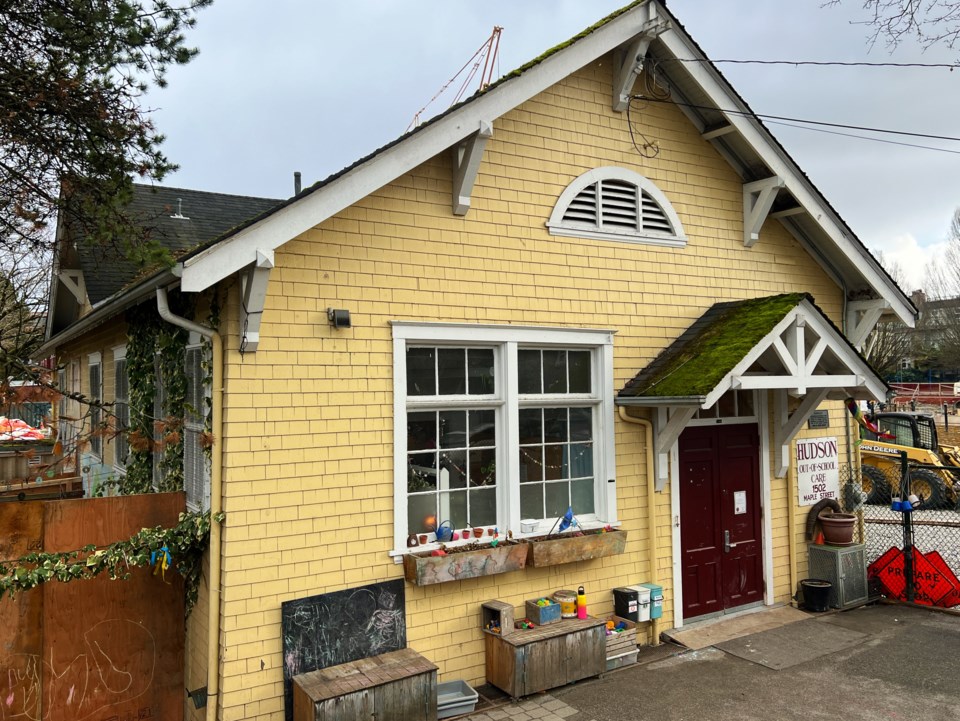A 110-year-old schoolhouse in Kitsilano will have a new home next week.
The two-story building has been standing at the corner of Cornwall and Maple streets since 1912, when Vancouverites still mostly got about by horse and carriage. A new school will be built on that property soon and originally the yellow schoolhouse was slated to be demolished.
However, that won't be happening; instead on Aug. 1 and 2 the 1,900 sq. ft. structure will be moved from its spot in Kitsilano to a new home on the Squamish Nation reserve beside the northern end of the Lions Gate Bridge, says Glyn Lewis of Renewal Home.
"It would have been tragic if this 110-year-old little schoolhouse was demolished," he says. "I'm hoping this story is a catalyst for a bigger conversation."
The process
When Lewis first heard about the building back in January, the Vancouver School Board already had plans in the works to demolish the old schoolhouse, which was being used by the Henry Hudson Child Care Society as a daycare. The site is being redeveloped into a larger, modern school.
"There's a general mindset of demolition first, which is really the wrong mindset," says Lewis, whose business seeks to save and move structures. "Our argument for years now is we need to move away from this demolition-first paradigm."
To that end, he met with the school board to encourage them to find a way to save the schoolhouse and move it to a place that needs it, and with the parks board, since it would need to travel through a park.
Initially, he found reluctance to consider the idea, but he later spoke with the Squamish Nation, who mentioned they needed a new 2,000 sq. ft. building for their young children's education programs, where their language and culture could be taught.
Once the Squamish were on board, Lewis says conversations with the two municipal boards changed dramatically.
"If it wasn't for the Squamish Nation the beautiful little yellow schoolhouse would be a pile of rubble," says Lewis.
Moving day is coming
Once the different groups got together plans moved smoothly and moving day for the old building is coming soon.
Nickel Brothers, a company that's moved thousands of buildings around B.C. and Washington state over the decades, has been contracted for the job. On Aug. 1 their crews will set up and, beginning at 10 p.m., move the building onto a truck and down Cornwall Avenue to the park area east of Kitsilano Pool at 1 a.m.
By 4 a.m. the schoolhouse will be moved to the beach where it'll be loaded onto a barge during high tide.
The barge will be towed out to English Bay where it will hang out for the day waiting for high tide to return.
Around 2 p.m. the building will be moved around Stanley Park and under the Lions Gate bridge; by 4 p.m. it should arrive on the Squamish reserve where it will be unloaded to be moved to its new home at 100 Capilano Rd. on Aug. 5. A foundation has already been poured.
"The goal is to have the schoolhouse reopen in September," says Lewis.

Why all the effort
It may seem like a lot of effort to move a house instead of building a new one, but Lewis notes it's a much more responsible and sustainable way to do things.
It also saves on costs associated with destroying and moving a structure and building a new one at the same time.
"The easy and fast thing is to demolish a building," Lewis says. "But it takes a little more thought to see there's a better solution there."
In the case of the yellow schoolhouse, there was a lot of value in the building in a lot of different ways. It is a functional, stable building upgraded about 15 years ago, Lewis notes. There's been generations of children who've learned in it; the children's society had "lived and loved" the building for decades.
The structure itself is impressive, he adds, noting how on a recent visit an engineer commented to him that it's built in such a way it would survive an earthquake better than its neighbours.
It was also built using old-growth timbers.
"The strength of the wood is incredible," Lewis says. "The salvage people salivate over buildings like that. It's got value every way you look at it."
On the other hand, Vancouver has become one of the demolition capitals of the world, as thousands of homes are demolished each year for new developments, he explains, with a growing population in an area where land is not plentiful, with water, mountains, and an international border blocking expansion.
"This region only has so much room to grow and so, for various and good reasons, grow up," he says. "The process to achieve that density is proving to be unbelievably wasteful."
He's hoping policymakers and developers will shift how they think towards a reuse and recycle model but for buildings. He's meeting with municipal governments and working on projects to show how it could work.
"Relocate and repurpose the buildings we can; deconstruct the rest," he says. "Machine demolition should be the last option, not the first."



